Animal domestication LECTURE 4
1/39
There's no tags or description
Looks like no tags are added yet.
Name | Mastery | Learn | Test | Matching | Spaced |
|---|
No study sessions yet.
40 Terms
Domesticated animals amounting to how much biomass of the terrestrial vertebrates
2/3
What are they used for
wool
leather
silk
food
movement→ transportation
Issues with close poximity to animals
zoonotic disease
What is an important part of animla domestication
Taming
→ dont want to get trampled!
Types of taming
Learning-based taming→ many wild animals can under go
Evolutionary reduction of aggression and fearfulness
Domestication differs from the standard mutualism
control over the domesticated
but can animals self-domesticate?
Dom plants vs Dom animals
many more plants domesticated
Domesticated animals main ones
Big five (herbivores)
sheep
goats
pigs
cattle
horses
Predators
dogs
cats
10 livestock
camel
yaks
chickens
Wild relatives still alive?
Yes for some
→ e.g red jungle fowl
But
NO
→ wild horses endangered
When did animals gets domesticated
Dogs
Cats
cattle and pigs
horses and chickens
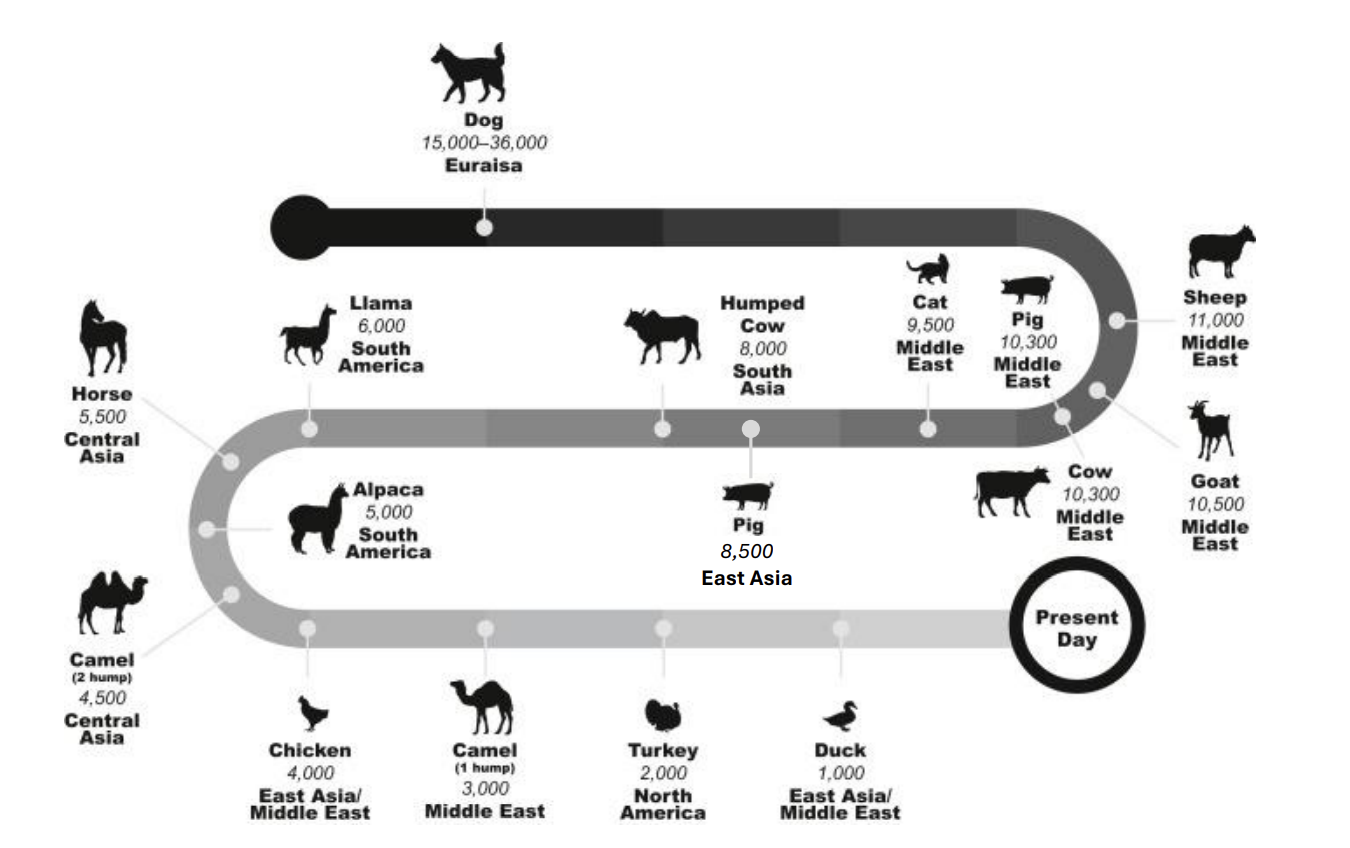
Where did domestication happen?
mainly Eurasia
→ no early domestications in Africa (despite being ancestral home)
How is the origin of domesticated species mapped?
Zooarchaeological evidence
Genetic Evidence
Types of evidence?
Behaviour of the species cannot be presered
(although some indirect clues e.g dental damage (due to bridle)
Decreased body size
reduced sexual dimorphisms→ due to herd managements
not evo change (so much be evidence of domestication NOT of evolution/change in species)
Difficulties of genetic evidence
Hybridisation with wild relatives + introgression→
cause overestimate the age of the domestic species
or number of independent domestication events
What is useful in genetic evidence?
Whole genomes
Ancient DNA
→ but still uncertainty
Found the domsetication ( two indepednet ones) in:
cattle
horses
dogs
pigs
Domestication of pigs→ well documented
Has caused domestic pigs to have higher genetic diversty than sympatric wild boar
This asymmetry of animal domstication
bit of a mystery!
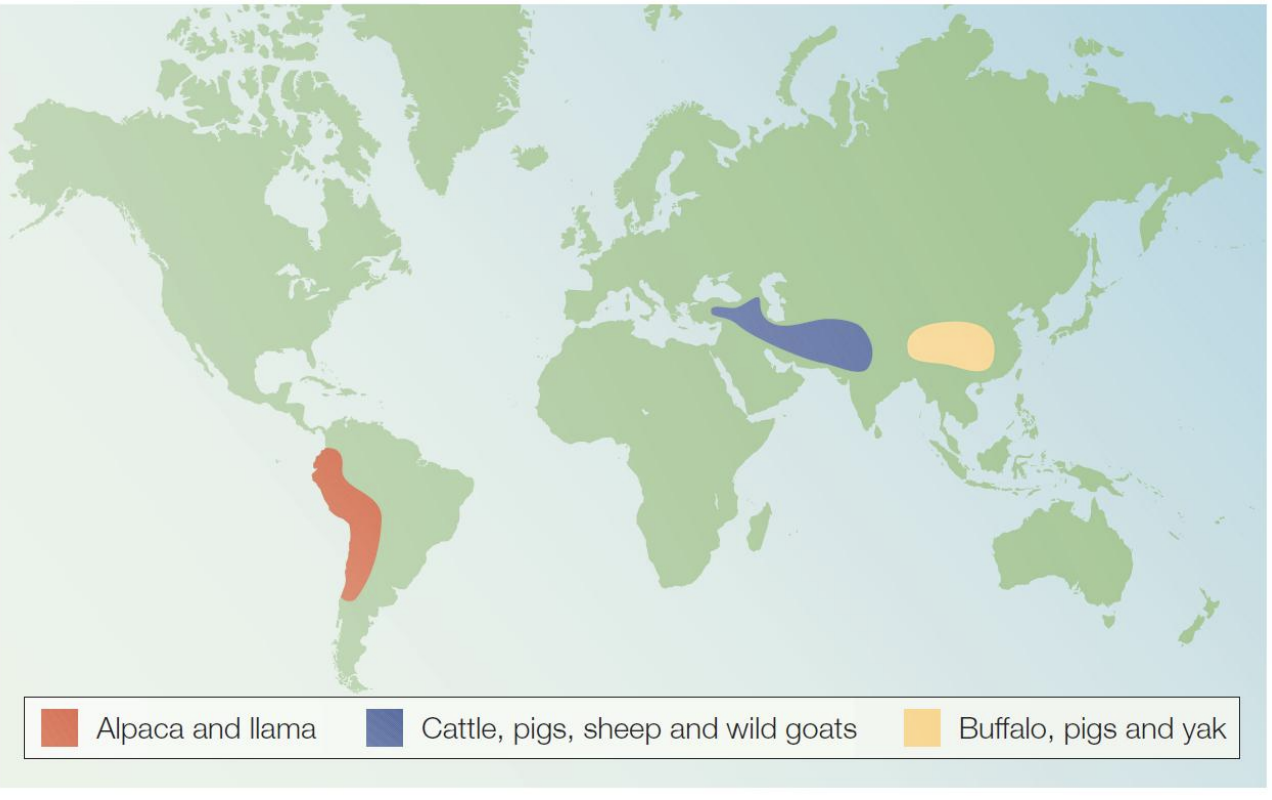
Where did vast majority of mammals originate from
Eurasia
WHY?
answer below
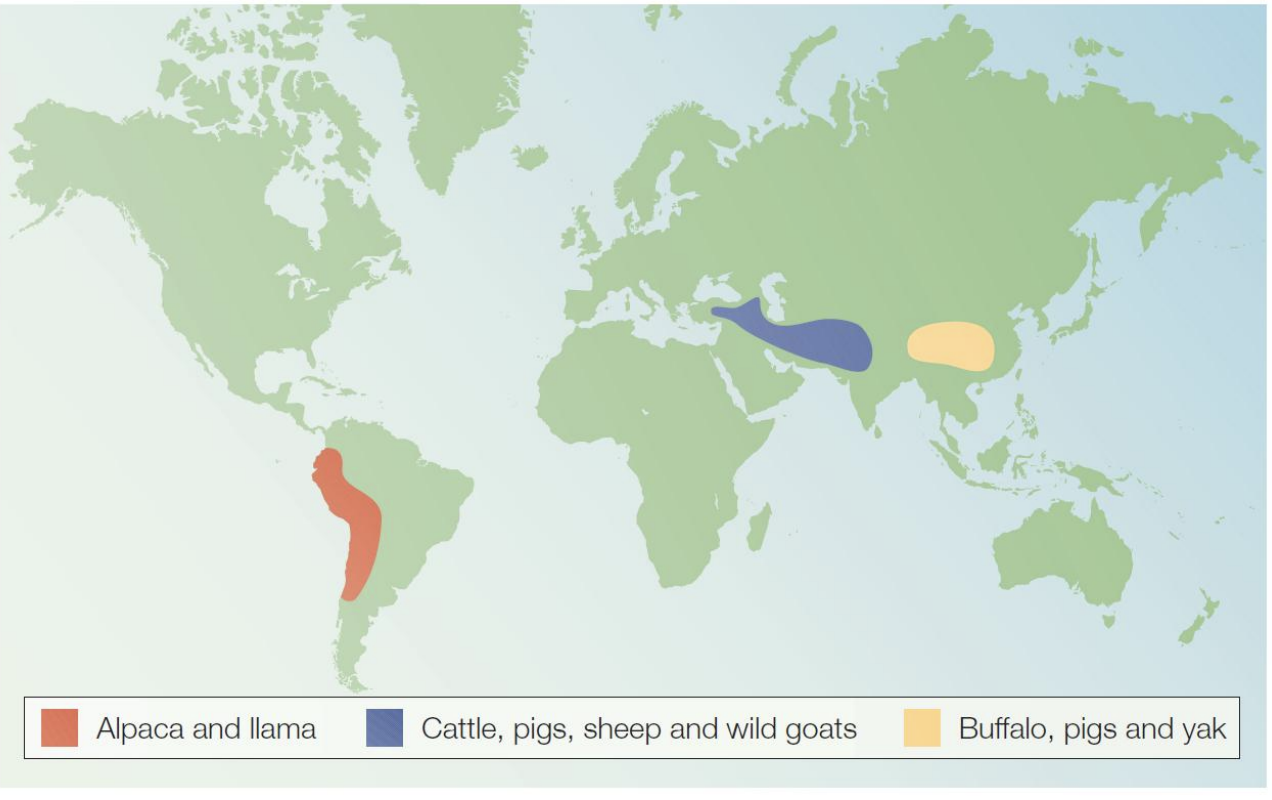
Conditions for domestication
Diet
carnivorus livestock need x 10 more than herbivores
specialist diets also hard to maintain
Growth Rate
must grow rapidly
Failture ot bred in captivity
captive breeding is needed for later stages of domestication
Too aggressive
can be too damgerous
Tendency to panic
don’t want it to do itsefl harm
Inappropriate social structure
if dont live in heards, hard to livestock
also need dominance hierachy that humans can hijack
Ways in which animal domestication can happen
Early→ accidental Commensal pathway
attracted to humans as tamer, less fearful
selected themselves into a partnership with humans
→ Commensal pathway
Or Early→ Manage groups of prey species Prey Pathway
to the point they began to control breeding
→ Prey Pathway
(most through this path)
Directed pathway
bred to promote traits
once knew what domestication could do
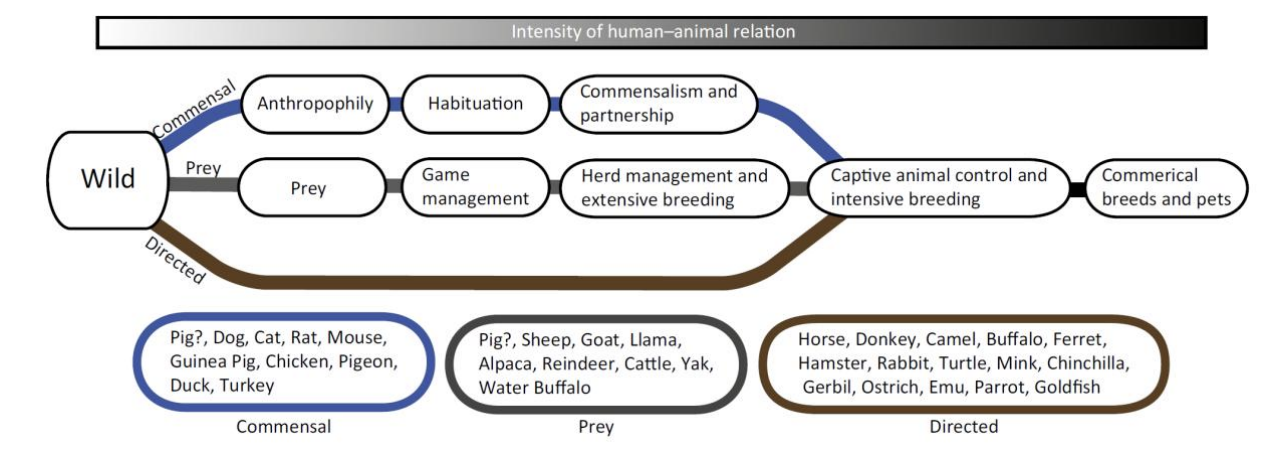
Why most domestic mammal progenitors from South Eurasia
Biogeopgraphy and influence of early farming
Traits they had:
non-tropical
moderate migratory
dependent on available drinking water
grazing adaptation
Environment needed for this:
cool
semi-arid
seasonaility→ migration
→ follow the leader social interactions (humans can hijack)
WHERE is this environment found??
→ S. Eurasia→ Fertile Crescent
also had the first dom plants
so good for animals to eat
Once Neolithic farmers then expanded out of Fertile Crescent
took their domesticated animals with them
Alternative explanation for Eurasian dominance
Only turn to prey management when prey numbers decrease
In Africa→ long co-habitation of humans and prey
→ prey do not decrease
BUT
In Americas→ humans were too successful at driving large mammals species extinct
INSTEAD→ Eurasia
Goldilocks zone of
Humans being able to prey on the animals
Balanced with
Not so vulnerable they dispappeared before domestication
Main traits wanted for domestication
Main→ tamness
The rest of the traits→ depends on the animals
frequent bouts of reproduction
breed more
smaller brain and teeth
different and variable colouration
floppy ears
shorter snout
curly tail
Is this a domestication syndrome?
Yes
BUT
Not all the traits are found all together
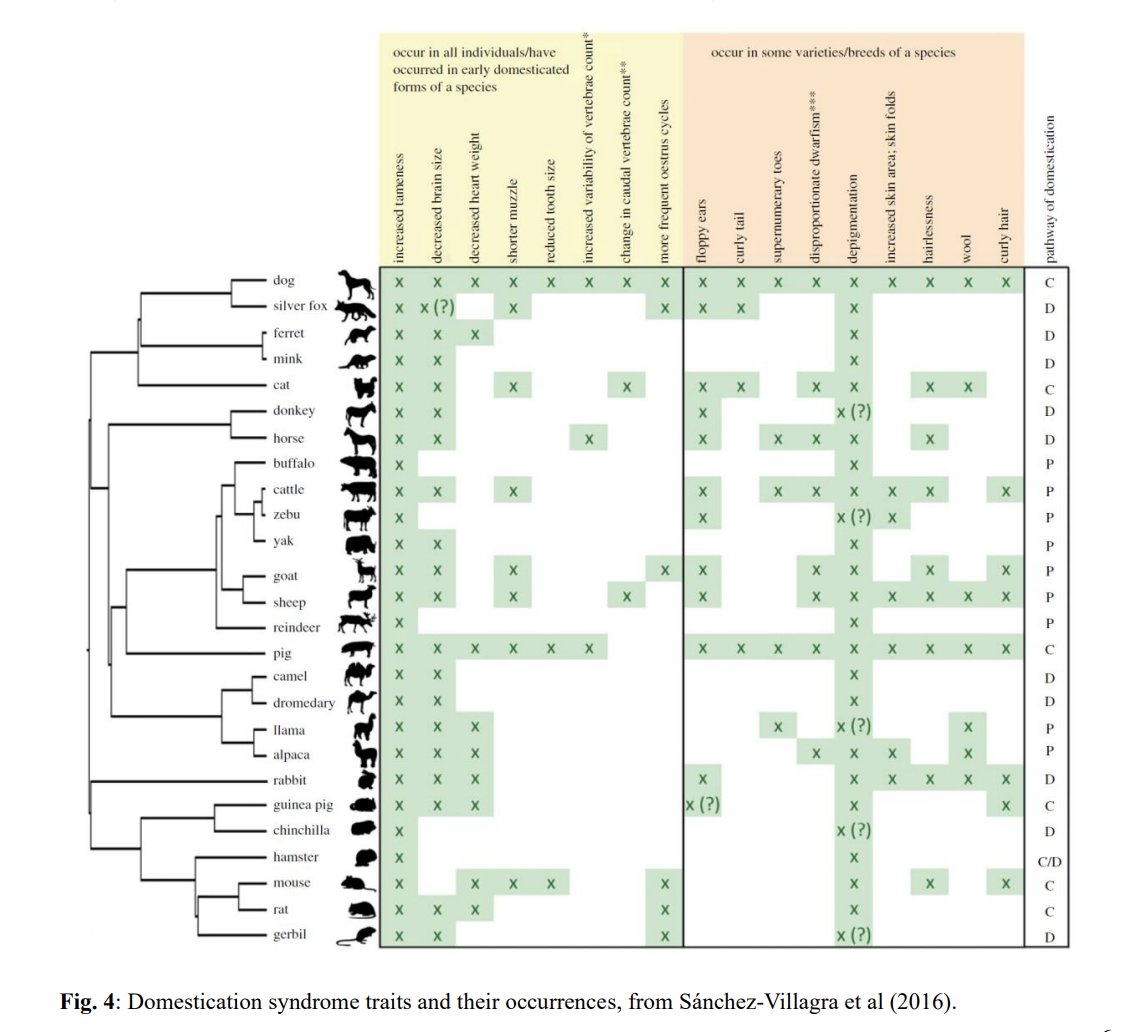
How to find out what caused the appearance of these traits?
Genomics
highlighting regions of genome associated with domestic traits
indicating the pattern of selection that might have brought them about
E.g study comparing genomes of goats and sheep→ found a homologous region
→ region that differentiated domestic from wild individuals
e.g KITLG gene→ coat colour in mammals
Goats→ region have higher diversity than wild
shows relaxed selection in domesticates
Sheep→ low diversity in region
show positive selection
desire white wool
E.g study between pigs and wild boar gene
e.g MC1R gene→ affect coat colour
Wild boar→ many mutations synonymous
indicate purifying selection
Pigs→ 9 non-synonymous mutations
suggests new coat colour variants appeared thanks to relaxed selection in a relatively predator -press environemnt
THEN: strong positive selection that quickly fixed these MC1R variatns in different breeds
The genetic basis of phenotypic diverstiy of dogs
50 regions of the genome
some traits = significant genetic variation at only 3 loci or less
→ likely the result of intense artificial selection for extreme phenotypes in different dog breed over the last 200 years
Overall this tells us that traits for domestication syndrome
various traits were directly selected for
or
result of the relaxed selection in a human-controlled environment
BUT: there is a different story→ Silver fox experiment
Silver fox experiment
captive silver foxes selected for tameness using criteria
within 6 generations, foxes inthe tame line were eager to eastablish human contact
whined when humans deparated
allowed themselves to be picked up, wagged their tails when humans arrives and licked their hands
Reproductive cycle also began earyl
From 10th generation→ other domestication traits began to appear:
floppy ears, piebald coats, shortened muzzle and upturned tail
But why would the selection of tameness alone cause the appearance of so many other aspects of domestication syndrome?
Genetic linkage?
NO: coz domestication genes are scattered throughout the genome
Selecting tameness→ accidently selecting for neoteny
prolonged expresseion of juvenile triats
into sexual matuirty:
e.g: behavourial or morphological factors
maturation of hypothalamic-pituitart adrenal axis→ give rise to a longer socialisation window
so animals can learn to regard humans as non-threatening
e.g in wolves this closes at 1.5 months but dogs 4-10 months
Most domestication syndrome traits would be influenced by neural crest cells
What is the neural crest?
embryoninc migratory cell population
unique to vertebrates
gives rise to melanocytes (pigment cells)
bones and cartilage of the head
pigmentation
skull shape
eat floppiness
ALSO
- adrenal glands→ hormones stress response
What is the hypothesis with the neural crest?
Domestication may be a mild neurocristopathy→ reduction in neural crest cell proliferation and/or function
Genetic support for this
many genes associated with domestication are involved in neural crest specification and function
Critics of this?→ Dogs
only dogs exhibit all traits of the domestication syndrome
BUT
even in dogs the traits are inconsistently expressed in different breeds
→ no obvious correlation with temperament
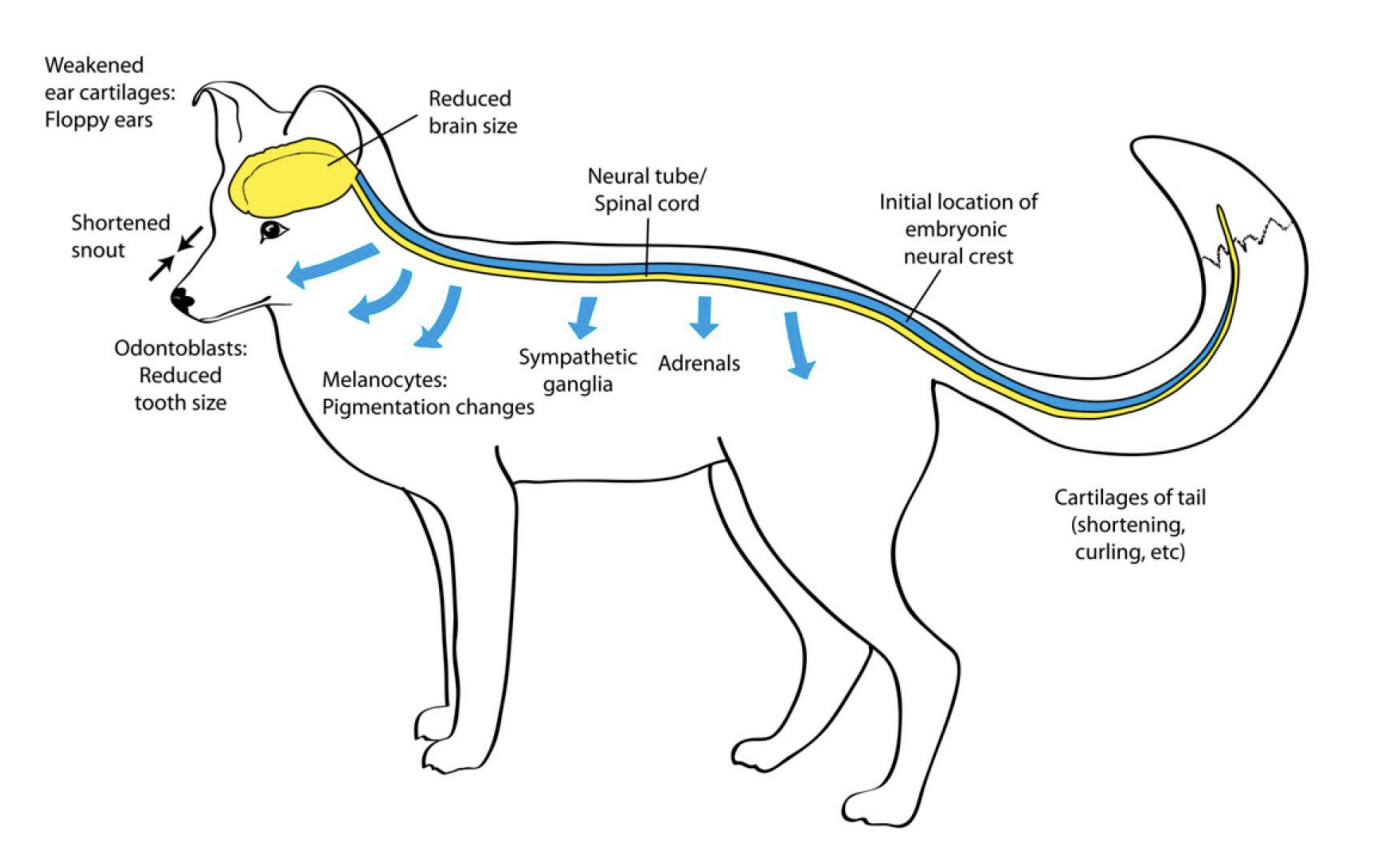
Domesticated traits in humans?
smaller teeth
shorter snout
variable skin and hair pigmentation
tolerence for other members of species
→ slected for tameness, by outselves??
But how can self-domestication happen?
Already one way to describe initial stages of commensal domestication pathway that dogs followed:
enhanced coopertative communicaiton seen in domestic animals
resonance with the origin of the human language or culture
Evidence for this?
→ several genes show evidence of positive selection in humans→ similarly been selected for in domesticated animals!
But is this too much a simplistic view?
do we really control our aggression better?
Are we in fact wild animals, but with sufficient emotional flexibility and control to live in domestic environment?
has this come with a cost??
Example essay questions
1. Why were almost all major domestic animal species domesticated in southern Eurasia?
2. What might have caused the appearance of morphological traits of the domestication syndrome in domestic animals?